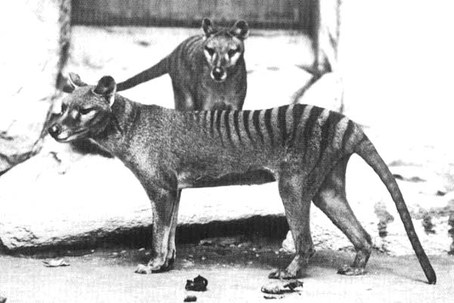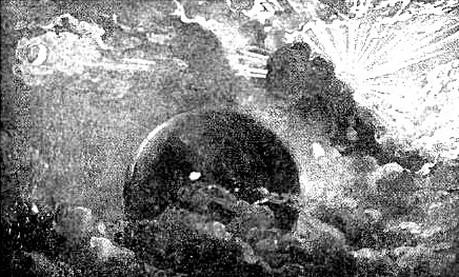
May 13, 1792
 Two Thylacine in captivity.
Two Thylacine in captivity. Almost exactly 150 years beforehand, in 1642 ,while Abel Tasman was being the first European to land on the Tasmanian Soil ( he named it Anthoonij van Diemenslandt or Van Diemen’s Land) one of his crew discovered tracks described as being not too different from those of a tiger.
However it was Jacques-Julian who got the first proper look at the animal, an almost dog like creature, that was just over a metre long, stood about 60cm high at the shoulder, was grey brown in colour, had a pouch, and a number of black stripes along its back.
Unfortunately, the Thylacine would become extinct less than 100 years later, the last one killed in the wild in 1930, and the last one dying in captivity in 1936. The saddest part of the Thylacines extinction was that it was finally granted protected species status just 59 days before 'Benjamin', the last of its kind, died from exposure after being locked out of its covered sleeping enclosure at the Hobart Zoo.
Still there is hope, with reported sightings of the Thylacine in the Tasmanian wilderness, it is thought the species may continue to live and has become one of Australia's signature cryptids.
May 16, 1975
 Norma Jean Armisted.
Norma Jean Armisted. Armistead was a nurse at Kaiser Hospital, and did have pregnancy on her medical charts, but many had dismissed this as at the age of 44, many thought Armistead too old. It got more mysterious when doctors gave her an examination and could not find any evidence that she had in fact given birth to the newborn, or any baby at all.
Before long the truth became clear when the body of 28 year old Kathryn Viramontes was discovered in an apartment, and the baby she was soon due to give birth too was missing. The killer had sliced open the victim’s abdomen, removing the newborn from her womb.
Norma Jean Armistead was found guilty of the murder. It was discovered that 9 months earlier she had made a false report on her pregnancy. Later she went through pregnant women’s records to find one due to give birth at the correct time, travelled to her house and murdered her. After a plea of insanity was dismissed, Armistead was sent to prison for life.
May 17, 1902
 The Antikythera Mechanism.
The Antikythera Mechanism. Two years later, in 1902, Archaeologist Spyridon (or Valerios Stais) discovered one of the chunks of rock had a corroded gear wheel embedded in it. After more analysis, including x-rays and gamma ray imaging, it was discovered that quite a complex device was located within the corroded mess of bronze and wood. Other parts of the device were found, and soon, with a bit of educated 'guess' work and hard engineering science, a more complete picture of the device, now called the 'Antikythera Device' was formed.
It is believed the device dates back from the first century BC, possibly older, and is made up of some 30 gears, possibly more that were lost, and is a one of a kind find being that such engineering was not seen again until some 14 centuries later.
It is believed that the device is a hand operated astronomical clock that measures the motions of the stars and planets. Although the devices function is not 100% confirmed, it is the intricate construction that is baffling, it is reason to cause a rethink in just what humans were capable of back in those days.
May 19, 1780
 Engraving of the dark day.
Engraving of the dark day. The darkness was by no means limited to those around New York, but rather all of the New England States and parts of Canada.
Many saw this unnatural darkness as a forewarning of an impending apocalyptic scenario – the end of the world perhaps?
A Religious view to the events saw it as signs of the return of Christ, especially when night fell and the moon and the stars were also obscured.
It was not until the middle of that night that the moon and the stars became visible.
This day was afterwards known as New England’s Dark Day. There were no astronomical events taking place at the time, no eclipses or anything like that. So what caused the unnatural darkness?
The most popular theory is that it may have been smoke from an overly large bushfire obscuring the light of the sun. This theory is not 100% proven, and if it is not the reason for the darkness then what was?





 RSS Feed
RSS Feed
